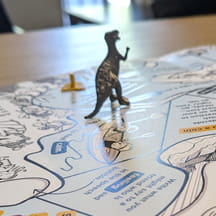"One of the molds didn't set for some reason and was unusable-it just turned to dust," says Wratchford, BCC, M.Div., M.H.A., CMP, supervisor, pastoral and spiritual care, Children's Hospital & Medical Center in Omaha, Nebraska. "We had to call the family and the mom said, 'Can I have the dust?' It emphasized to me how important these items are to the families."
That incident prompted Wratchford and his team to seek out a better solution to produce the keepsake molds.
Emerging technology shows promise as alternative
"This has made my job much more personal by allowing us to impact families beyond just the patient we're caring for-it enables us to give even more than we thought we could."
Gabe Linke, 3D printing coordinator, Children's Hospital & Medical Center
During this time, Children's Omaha was building a robust 3D printing program. While the program initially focused on clinical applications—primarily anatomical models of patients to aid physicians in planning surgeries and educating parents on their child's condition—leveraging the technology for palliative purposes made sense.
There were logistical challenges to overcome; chief among them was the need for specialized 3D printing equipment to accommodate the mold casting process. But the concept was too promising for Wratchford to ignore.
"When the 3D scanning idea came about, I just knew we had to do it; we were committed to looking for ways to make it happen," Wratchford says. "We got a grant from a family who gave us just the right amount of money, so we went for it—it's been one of the best things we've done."
3D printing solves traditional method's shortcomings
Over the last two years, Children's Omaha has produced about 120 sets of 3D printed molds. The new technique eliminates the primary problems associated with the old plaster models:
- Durable. The 3D printed hands and feet are molded with a sturdy resin so they're virtually indestructible. With the plaster molds, "some families were so afraid to touch them that they'd put them in lockboxes and safes and not really be able to utilize them," Wratchford says.
- Replaceable. Each mold is saved in the hospital's system so in the unlikely event one breaks or is lost, it can easily be reprinted. "One of our families had their house burglarized and their molds were stolen; that was the one item they most cherished and wanted back," Wratchford says. "We wouldn't have been able to do that before."
- Precise. The new 3D scanning equipment provides a level of detail never possible before, picking up creases of knuckles, skin follicles and sometimes even fingerprints. Wratchford recalls one instance where the equipment replicated a patient's birthmark. "When we gave the mother the mold of her child's foot, the very first thing she did was feel for that bump," Wratchford says. "She said ‘Omigosh, it's there!' and started crying because she knew it was her child's foot."
Molds help parents through integral part of grieving process
Perhaps the most important benefit of the 3D printed molds is the role they play in the bereavement process, according to Wratchford. He says continuity—being able to carry the memory of their loved one into the future—is a vital step in the grieving process. The molds provide a durable and replicable way to help parents build that continuity.
"This allows us to give them something that really will last forever," Wratchford says. "They no longer have to fear they'll lose it or break it and have to grieve again with that loss."


